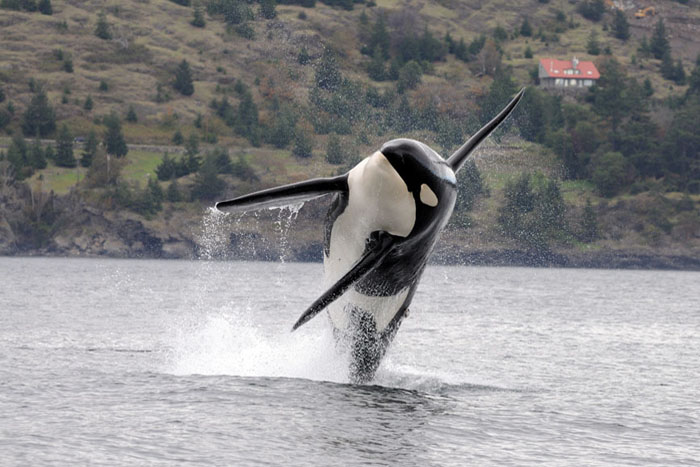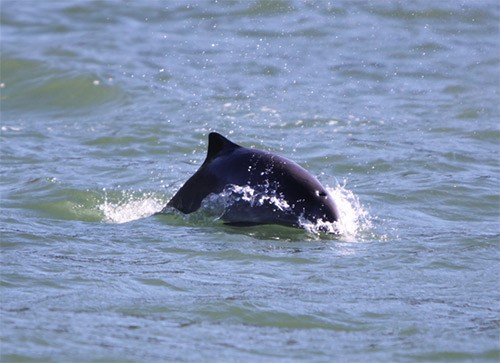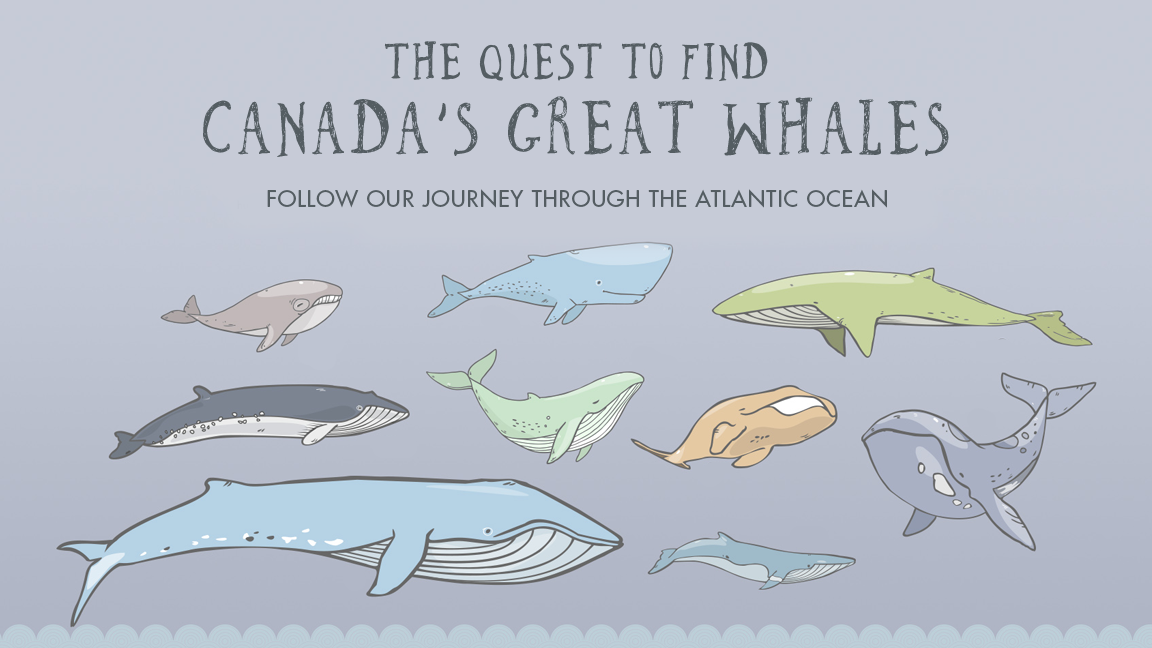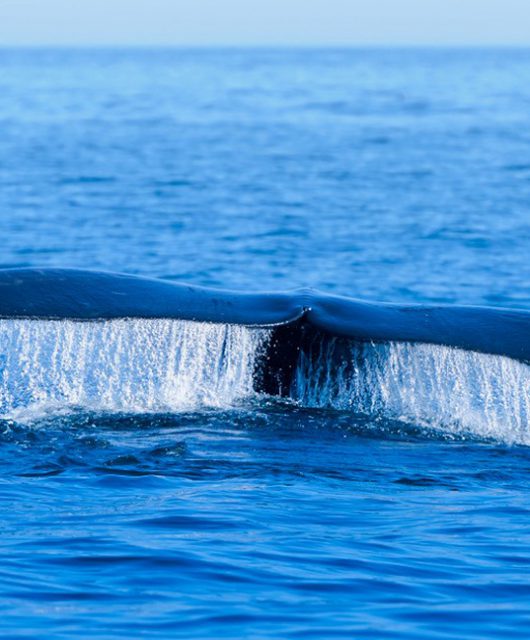Collectively, whales, dolphins and porpoises are marine mammals belonging to the order Cetacea (derived from the Greek word ketos, meaning “large sea creature”).
Known together as cetaceans, many people often use these terms interchangeably – while they share many things in common, there are differences between the three that make each group unique and distinct from the rest!
Within the Cetacea order are two suborders:
- Mysticeti – the “great” whales or baleen whales
- Odontoceti – the toothed whales
The Delphinidae (oceanic dolphins) and Phocoenidae (porpoises) families belong to the toothed whales. While dolphins and porpoises belong to separate families, with differences in looks and genetics from whales, all dolphins and porpoises can be considered whales taxonomically, but not all whales are dolphins or porpoises.
Whales

The term “whale” is often reserved to distinguish species based on their size, with whales typically being much larger than their counterparts. This is especially true for the baleen whales which are some of the largest animals on the planet, like Blue and Fin Whales, and the larger toothed whales such as the Sperm Whale.
Beyond size, the following are other characteristics that separate whales from dolphins and porpoises.
Dorsal Fins
The first difference is the size of their dorsal fins relative to their body size. While dolphins tend to have well-defined dorsal fins, whales comparatively have tiny or even no dorsal fin (such as the Beluga Whale).
Neck Vertebrae
The second difference can be found in their neck vertebrae. Whales have evolved over time to have fused neck vertebrae – an adaptation that helps them to support the weight of their heads, while some dolphins have flexible necks.
Dolphins

Having teeth differentiates dolphins from whales in more ways than simple dentition.
Whales in the Mysticeti suborder have baleen plates, which means their diet differs a lot from dolphins’ diet. Dolphins will prey on fish and squid that they can grasp with their teeth, while baleen whales prey upon tiny crustaceans like krill and copepods.
This also means dolphins have evolved different strategies for gathering food. Dolphins rely heavily on the use of echolocation for hunting and navigation, where baleen whale songs are used for communication.
Here are several physiological differences between the two subgroups.
Blowholes
There are several differences between their blowholes. Baleen whales have two blowholes, while the toothed whales, and subsequently dolphins and porpoises only have one. The structure of dolphin blowholes is also different from both whales and porpoises, which allows them to make a variety of whistle sounds to communicate with others.
Brains
Dolphins (and toothed whales) have some of the largest brains relative to their body size of any animals and are highly intelligent. In fact, Killer Whales have the second largest brain of any animal, only behind the Sperm Whale.
Social
Dolphins and toothed whales have a different social structure from most large whales. Dolphins are highly social animals that live in large groups or pods of related animals, where they help each other hunt, play, and rear offspring. Meanwhile, the large whales tend to be more solitary, aggregating in shared feeding grounds or for breeding.
Body Shape
Dolphins have a very different body shape in comparison to whales – dolphins are leaner with torpedo shaped bodies and elongated beaks.
Common species that belong to the dolphin family include include Killer Whales, Pilot Whales, and False Killer Whales.
Porpoises

The most common misidentification of cetaceans is between dolphins and porpoises – both belonging to the toothed whale family. However, there are several differences between them.
Teeth
The biggest difference between porpoises and dolphins is their teeth. Dolphins have cone-shaped teeth, where porpoises have flat, spade-shaped teeth. However, it is not easy to see their teeth at a quick glance. Luckily, there are some external differences between them.
Dorsal Fins
Dolphins usually have curved or sickle-shaped dorsal fins, while porpoises’ dorsal fins are more triangular shaped. Dolphins also tend to have a longer and more pointed beak, while porpoises have a shorter face, and an overall more rounded body than the leaner dolphins.
Communication
Just like the differences between the baleen and toothed whales, there are differences between dolphin and porpoise communication. Dolphins are very chatty, making a range of noises that are audible to the human ear. Porpoises, however, communicate at a higher frequency that we cannot hear, and less often than dolphins.
Social Groups
Porpoises tend to travel is smaller groups, and have more subdued surface behaviour, compared to their aerobatic dolphin cousins. It is thought that these differences help porpoises to evade predation (e.g. by Killer Whales), by staying under the radar, while dolphins have the advantage of large group sizes and speed to protect them.



12 comments
Thank you so much for posting this interesting information. It has opened my eyes to the many differences and similarities of our marine mammalian friends. I was especially intrigued by the fact that baleen whales have to blowholes. It would be fascinating to learn what the two different blowholes “porpoises” are. {HaHa!} Thanks!
Please note the following correction – “I was especially intrigued by the fact that baleen whales have to blowholes.” – “to” should be “two”
Thank you for the correction, Mr. Peschong. Your first comment had me confused for the longest time, but this clears things up!
I apologize for any confusion I may have caused! This was never my intention. I seek only to educate myself, and further the education of those around me. I’m getting a bit em-ocean-al even thinking about causing you distress! Hopefully I can make it up to you.
Hello, please consider revising your article to more clearly and consistently state that Dolphins are in fact whales. Toothed whales, as you do say. But you then go on to say dolphins are different from whales. This is inconsistent terminology. Baleen whales, or great whales, are not the only whales.
Please help clarify this as many people are confused.
Very interesting point. I would love to hear what CWF has to say about this. Thank you for sharing your opinion! Its always good to hear from other Cetacea heads.
Mysticeti whales (are baleen whales or great whales) they are bigger on usuually and are filter feeders.From what I understand is the name Mysticeti means some thing like “mustache ” and refers to an structure near the mouth made of keratin (the same as hair or finger nails in humans) that allows thes whales to filter the water for food.
Is Baleen another name for the this structure?
The other group Odontoceti (have teeth ) the largest of this group is the sperm whale. They have to hunt for food.
I also hear but not sure if it was correct but a lot of whale parts have strange names as they were named by the butchers that hunted them.